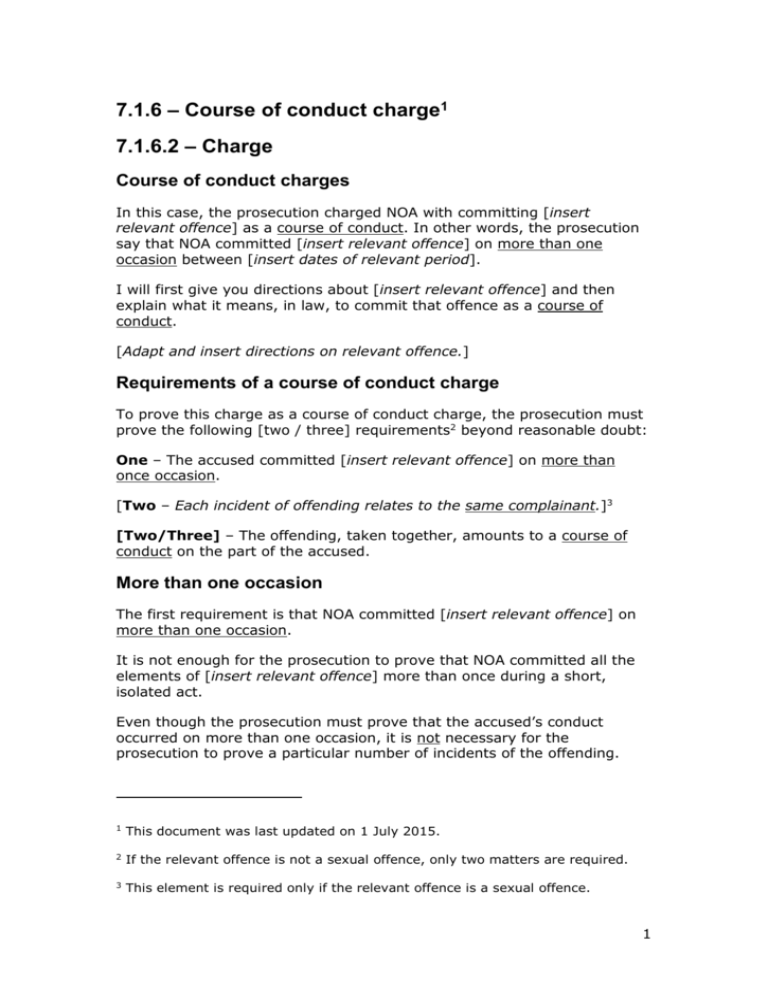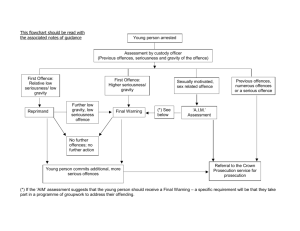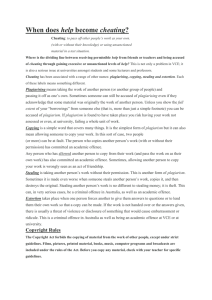
7.1.6 – Course of conduct charge1
7.1.6.2 – Charge
Course of conduct charges
In this case, the prosecution charged NOA with committing [insert
relevant offence] as a course of conduct. In other words, the prosecution
say that NOA committed [insert relevant offence] on more than one
occasion between [insert dates of relevant period].
I will first give you directions about [insert relevant offence] and then
explain what it means, in law, to commit that offence as a course of
conduct.
[Adapt and insert directions on relevant offence.]
Requirements of a course of conduct charge
To prove this charge as a course of conduct charge, the prosecution must
prove the following [two / three] requirements2 beyond reasonable doubt:
One – The accused committed [insert relevant offence] on more than
once occasion.
[Two – Each incident of offending relates to the same complainant.]3
[Two/Three] – The offending, taken together, amounts to a course of
conduct on the part of the accused.
More than one occasion
The first requirement is that NOA committed [insert relevant offence] on
more than one occasion.
It is not enough for the prosecution to prove that NOA committed all the
elements of [insert relevant offence] more than once during a short,
isolated act.
Even though the prosecution must prove that the accused’s conduct
occurred on more than one occasion, it is not necessary for the
prosecution to prove a particular number of incidents of the offending.
1
This document was last updated on 1 July 2015.
2
If the relevant offence is not a sexual offence, only two matters are required.
3
This element is required only if the relevant offence is a sexual offence.
1
[If the relevant offence comprised different types of acts on different
occasions, add the following shaded section.]
As I have already told you, [insert relevant offence] may be committed in
different ways. [Insert summary of different acts alleged to have
constituted the offence, for example, digital penetration one on occasion
and by penetration with an object on another.]
As long as the accused committed [insert relevant offence] on more than
one occasion, it does not matter that the acts making up that offence
were different from one occasion to another.
Specificity not required
Because the prosecution has charged NOA with committing [insert
relevant offence] as a ‘course of conduct’, the prosecution does not need
to prove a single, identified, event. It is not necessary for the prosecution
to prove the dates, times, places, circumstances or occasions of the
incidents of the accused’s conduct, as long as the prosecution shows that
the accused committed the offending on more than one occasion over the
specified period.
The prosecution does not need to prove the general circumstances of any
particular incident or the exact number of incidents.
Same complainant
[If the relevant offence is a sexual offence, add the following shaded
section.]
The second requirement is that each incident of the offence relates to the
same complainant.
[If this requirement is not in issue, add the following shaded section.]
In this case it is not disputed that, if the incidents occurred, they related
to the same complainant. You should therefore have no difficulty finding
this requirement proven.
Course of conduct
It is not enough for the prosecution to prove that the accused committed
[insert relevant offence] [relating to NOV] on more than one occasion.
The [second/third] requirement is that the occasions of offending, taken
together, must amount to a course of conduct by the accused.
It is up to you to decide whether you are satisfied that the accused’s
conduct amounted to a course of conduct.
2
To determine this element, you must consider whether the time, place or
purpose of the occasions of offending, or any other matter, indicates that
the accused has engaged in a “course of conduct”. You must consider
whether there is sufficient repetition or pattern in the offending to show
that it is a ‘course of conduct’.
Let me give you three examples. First, if a person committed the same
offence at the same time every week, such as on a Monday evening, for 3
months, it would be easy to say that the offending involved a course of
conduct. Second, if an offender committed a sexual assault on a person
whenever that person stayed over at the offender’s house, and this
happened 5 times over a year, you might say that was a course of
conduct or you might not. Third, if, in the second example, the offending
only occurred twice in a year, you might find it harder to say this was a
‘course of conduct’, rather than two isolated occasions.
These are just examples. Any kind of regularity or pattern in the offending
will make it easier for you to be satisfied beyond reasonable doubt that
there was a course of conduct.
[Add any of the following, as relevant:
A course of conduct can be proved by evidence in the form of
what would typically or routinely occur, rather than by the
details any individual occasion or occasions of the offence.
It is not necessary to be satisfied of the exact number of
incidents of the offending, or of the circumstances of any one
individual incident, in order to find a course of conduct.
It is also not necessary to focus on any distinctive or unusual
features of any individual incidents in determining whether the
accused engaged in a course of conduct.
The higher the number of occasions of offending, the easier it
will be to find a course of conduct, particularly where the
incidents form a regular or systematic pattern of conduct by the
accused. On the other hand, where there are fewer occasions of
offending, it will likely be more difficult to find that the offending
amounted to a course of conduct.]
What the prosecution must prove is that between [insert relevant dates],
NOA [statement of offence, e.g. ‘intentionally took part in an act of sexual
penetration with a child under 16, NOV’] as a course of conduct.
[If this element is not in issue, add the shaded section.]
In this case it is not disputed that, if the alleged incidents occurred, they
amounted to a course of conduct by the accused. You should therefore
have no difficulty finding this requirement proven.
Application of Law to Evidence
3
[If not previously done, apply the law to the relevant evidence here.]
Summary
To summarise, before you can find NOA guilty of committing [insert
relevant offence] as a course of conduct, the prosecution must prove to
you beyond reasonable doubt:
[Insert elements of primary offence]
and
One – The accused committed [insert relevant offence] on more than
once occasion; and
[Two– Each incident relates to the same complainant];4 and
[Two/Three] – The offending, taken together, must amount to a course
of conduct by the accused.
If you find that any of these requirements has not been proved beyond
reasonable doubt, then you must find NOA not guilty of committing [insert
relevant offence] as a course of conduct.
This element is required only for course of conduct charges relating to sexual
offences.
4
4







